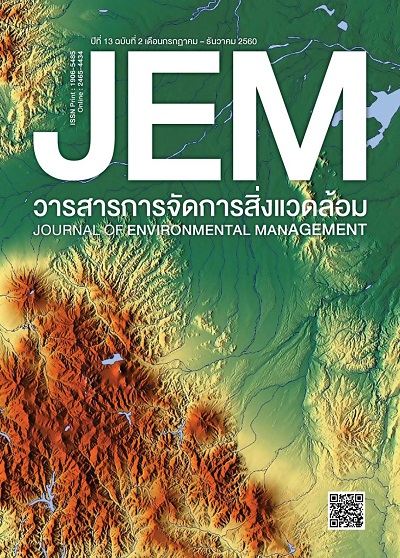แรงจูงใจในการใช้ประโยชน์ที่ดินเกษตรกรรมบนพื้นที่สูง ตำบลวาวี อำเภอแม่สรวย จังหวัดเชียงราย MOTIVATION FOR AGRICULTURAL LAND USE IN THE HIGHLAND OF WAWEE SUB-DISTRICT, MAE SUAI DISTRICT, CHIANG RAI
บทคัดย่อ
การวิจัยนี้เป็นการศึกษาแรงจูงใจในการใช้ประโยชน์ที่ดินของเกษตรกรบนพื้นที่สูง กรณีศึกษา ตำบลวาวี อำเภอแม่สรวย จังหวัดเชียงราย โดยแบ่งกลุ่มตัวอย่างออกเป็น 3 กลุ่มใหญ่ๆ ได้แก่ เกษตรกรที่ปลูกข้าวโพดอย่างเดียว เกษตรที่ปลูกพืชผสมผสาน และเกษตรกรที่ไม่ปลูกข้าวโพด โดยใช้แบบสอบถามสัมภาษณ์ด้วยวิธีการสุ่มตัวอย่างแบบเจาะจง กลุ่มละ 50 ตัวอย่าง รวมทั้งสิ้น 150 ตัวอย่างการวิเคราะห์ข้อมูลใช้โปรแกรม SPSS เพื่อวิเคราะห์หา ค่าเฉลี่ย ผลการศึกษาพบว่า แรงจูงใจในการใช้ประโยชน์ที่ดินเกษตรกรรมบนพื้นที่สูงที่แตกต่างกันนั้นมาจากจำนวนที่ดินที่ครอบครองที่แตกต่างกันและความแน่นอนของตลาดรับซื้อผลผลิต โดยพบว่า กลุ่มที่ปลูกข้าวโพดมีพื้นที่ครอบครองโดยเฉลี่ยน้อยที่สุด คือ ไม่เกิน 5 ไร่ รองลงมา คือ กลุ่มที่ปลูกพืชผสมผสาน 11-15 ไร่ และกลุ่มที่มีที่ดินครอบครองมากที่สุด คือ กลุ่มที่ไม่ปลูกข้าวโพดเลยซึ่งส่วนใหญ่ทำการปลูกกาแฟมีจำนวนที่ดินที่ถือครอง 21 ไร่ขึ้นไป โดยกลุ่มที่มีที่ดินน้อยนั้นให้เหตุผลว่าไม่สามารถแบ่งพื้นที่สำหรับการปลูกพืชชนิดอื่นแทนข้าวโพดได้และมีความคิดเห็นว่าการปลูกข้าวโพดดีกว่าพืชชนิดอื่นที่สามารถขายได้ทั้งหมดและยังเป็นที่ต้องการของตลาดอย่างต่อเนื่องและไม่จำกัด จึงตัดสินใจปลูกข้าวโพดเหมือนเดิม
This research studies the motivation of the highland people regarding the cultivation of different crops for a case study in the Wawee subdistrict, Mae Suai district, Chiang Rai province. The study used questionnaires and random sampling of total 150 samples, sub-divided into 3 groups of 50 farmers that practice maize as single-crop cultivation, mixed-crop cultivation, and non-maize cultivation. Data analysis included the mean scores using SPSS software. The analysis presented that most of agricultural land use depended on the size of farmland or the market demanding. The singlecrop farmland (maize) has occupied a minimum of land of no more than 5 rai on average, while the mixed-crop farmland has occupied no more than 15 rai on average. The non-maize farmland group–mostly cultivating coffee, occupied land of more than 21 rai. In sum, highland people, who occupied less than 5 rai, gives the reason that they cannot allocate land for other crops to replace maize cultivation. They said maize can be sold out and has unlimited market demand. That is why most of highland people remain cultivating maize.
References
Dontree, S., Humtakhop, S., Chamniwikaiyapong, P., & Noisuya, S. (2012). Prioritizing of Burned Areas Using Multi-Source Spatial Data for Open Field Burning Surveillance and Prevention in Chiang Mai Province [In Thai]. Final research report, Thai Universities for Healthy Public Policies.
Janklan, K. (2006). Influence Factors on decision making in maize plantation of famers in Songkla Province [in Thai]. Master’s thesis, Agribusiness Management, Faculty of Economics, Prince of Songkla University.
Meejui, S. & Surapornphaiboon, P. (2009). Development Project on Suitable Alternative Agricultural System to substitute rice cultivation on slope area with the participation of the farmers in Nan Province [In Thai]. Research Report, Thailand Research Fund (TRF).
Ministry of Agriculture and Cooperatives in collaboration with Highland Research and Development Institute (Public Organization). (2016). Manual for rice cultivation using no-tillage and overlapping with Fabaceae [In Thai]. Retrieved July 03, 2016, from http://hkm.hrdi.or.th/knowledge/d etail/271
Sirimongkonlerkun, N. & Kongmee, S. (2014). Study on factor affecting to the decision making in corn plantation in hilly area – a case study in Wawee sub-district, Mae Sruai district, Chiang Rai province, Thailand [in Thai]. Far Eastern University Academic Review, 8(1), 163 – 171.
Sirimongkonlerkun, N. & Ponglirat, S. (2013). Open space risk map from multiple sources in Chiang Rai province [In Thai]. Research Report, Chiang Mai Public Policy Promotion Plan, Chiang Mai University.
Somsopha, K., Premprasith, R., Boonyanuphab, J., & Premprasith, S. (2016). Study on Land Use and Suitable Cropping to Substitute Maize Cultivation in Slope Area of Nan Province [In Thai]. Retrieved July 09, 2016, from http://conference.nu.ac.th/nrc12/downloadPro.php?pID=98&file=98.pdf
Sustainable Agriculture Foundation Thailand. (2016). Sustainable Agricultural System, Shifting Cultivation [In Thai]. Retrieved July 16, 2016, from http://www .sathai.org
Talerngsri, K. & Pongkijvorasin, S. (2010). Maize for Livestock – Mechanisms to Inequality at the Local Level – A Case Study of Maize Cultivation Chain for Livestock in Wiengsa District, Nan Province [In Thai]. Research Report, Faculty of Economics, Chulalongkorn University.


